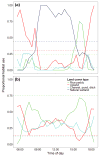Movement analysis of free-grazing domestic ducks in Poyang Lake, China: a disease connection
- PMID: 27695384
- PMCID: PMC5042146
- DOI: 10.1080/13658816.2015.1065496
Movement analysis of free-grazing domestic ducks in Poyang Lake, China: a disease connection
Abstract
Previous work suggests domestic poultry are important contributors to the emergence and transmission of highly pathogenic avian influenza throughout Asia. In Poyang Lake, China, domestic duck production cycles are synchronized with arrival and departure of thousands of migratory wild birds in the area. During these periods, high densities of juvenile domestic ducks are in close proximity to migratory wild ducks, increasing the potential for the virus to be transmitted and subsequently disseminated via migration. In this paper, we use GPS dataloggers and dynamic Brownian bridge models to describe movements and habitat use of free-grazing domestic ducks in the Poyang Lake basin and identify specific areas that may have the highest risk of H5N1 transmission between domestic and wild birds. Specifically, we determine relative use by free-grazing domestic ducks of natural wetlands, which are the most heavily used areas by migratory wild ducks, and of rice paddies, which provide habitat for resident wild ducks and lower densities of migratory wild ducks. To our knowledge, this is the first movement study on domestic ducks, and our data show potential for free-grazing domestic ducks from farms located near natural wetlands to come in contact with wild waterfowl, thereby increasing the risk for disease transmission. This study provides an example of the importance of movement ecology studies in understanding dynamics such as disease transmission on a complicated landscape.
Keywords: disease transmission; domestic poultry; dynamic Brownian bridge movement model.
Conflict of interest statement
statement No potential conflict of interest was reported by the authors.
Figures



Similar articles
-
Migration of waterfowl in the East Asian flyway and spatial relationship to HPAI H5N1 outbreaks.Avian Dis. 2010 Mar;54(1 Suppl):466-76. doi: 10.1637/8914-043009-Reg.1. Avian Dis. 2010. PMID: 20521681 Free PMC article.
-
Risks of avian influenza transmission in areas of intensive free-ranging duck production with wild waterfowl.Ecohealth. 2014;11(1):109-19. doi: 10.1007/s10393-014-0914-2. Epub 2014 Mar 21. Ecohealth. 2014. PMID: 24652313 Free PMC article.
-
Emergence and evolution of H10 subtype influenza viruses in poultry in China.J Virol. 2015 Apr;89(7):3534-41. doi: 10.1128/JVI.03167-14. Epub 2015 Jan 14. J Virol. 2015. PMID: 25589662 Free PMC article.
-
Origin and evolution of highly pathogenic H5N1 avian influenza in Asia.Vet Rec. 2005 Aug 6;157(6):159-64. doi: 10.1136/vr.157.6.159. Vet Rec. 2005. PMID: 16085721 Review.
-
Vaccination of domestic ducks against H5N1 HPAI: a review.Virus Res. 2013 Dec 5;178(1):21-34. doi: 10.1016/j.virusres.2013.07.012. Epub 2013 Aug 3. Virus Res. 2013. PMID: 23916865 Review.
Cited by
-
Global phylodynamic analysis of avian paramyxovirus-1 provides evidence of inter-host transmission and intercontinental spatial diffusion.BMC Evol Biol. 2019 May 24;19(1):108. doi: 10.1186/s12862-019-1431-2. BMC Evol Biol. 2019. PMID: 31126244 Free PMC article.
-
Habitat loss exacerbates pathogen spread: An Agent-based model of avian influenza infection in migratory waterfowl.PLoS Comput Biol. 2022 Aug 18;18(8):e1009577. doi: 10.1371/journal.pcbi.1009577. eCollection 2022 Aug. PLoS Comput Biol. 2022. PMID: 35981006 Free PMC article.
-
Integrated 16S rRNA and metagenomic sequencing reveals the distribution of key antibiotic resistance genes in duck gut microbiota.Poult Sci. 2025 Jul;104(7):105206. doi: 10.1016/j.psj.2025.105206. Epub 2025 Apr 23. Poult Sci. 2025. PMID: 40294554 Free PMC article.
-
Duck gut metagenome reveals the microbiome signatures linked to intestinal regional, temporal development, and rearing condition.Imeta. 2024 May 14;3(4):e198. doi: 10.1002/imt2.198. eCollection 2024 Aug. Imeta. 2024. PMID: 39135685 Free PMC article.
-
Could Changes in the Agricultural Landscape of Northeastern China Have Influenced the Long-Distance Transmission of Highly Pathogenic Avian Influenza H5Nx Viruses?Front Vet Sci. 2017 Dec 19;4:225. doi: 10.3389/fvets.2017.00225. eCollection 2017. Front Vet Sci. 2017. PMID: 29312966 Free PMC article.
References
-
- Beyer HK. [Accessed 29 January 2015];Geospatial modelling environment software. 2014 [online]. Available from: www.spatialecology.com.
-
- Bin MS, et al. Rice production systems and avian influenza: interactions between mixed-farming systems, poultry and wild birds. Waterbirds. 2010;33(sp1):219–230. doi: 10.1675/063.033.s116. - DOI
Grants and funding
LinkOut - more resources
Full Text Sources
Other Literature Sources
